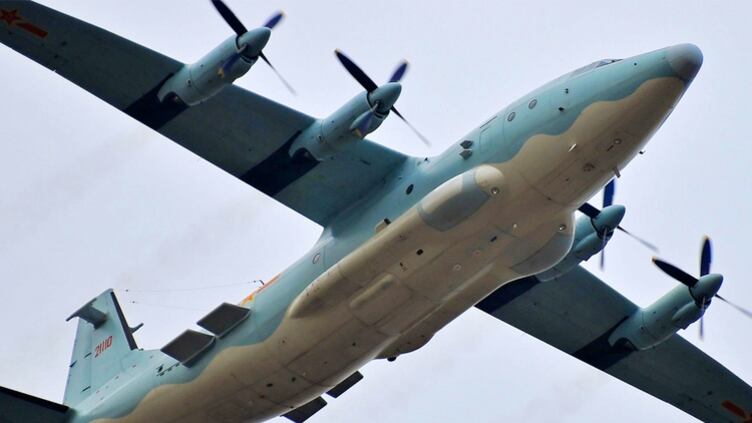The Chinese military has a new warplane with an unusual purpose: to beam propaganda and disinformation into hostile territory.
In that way, the new, four-engine Y-8GX7 psychological operations plane—also known by its Chinese name, Gaoxin-7—is analogous to the U.S. Air Force’s EC-130J, which it says “conducts military information support operations and civil affairs broadcasts in F.M. radio, television and military communications bands.”
A flying radio outpost might seem rather retro, even quaint, in the internet era. But in many of the world’s worst conflict zones, internet access is limited—and people still get much of their information from radio and television.
EC-130s—which has its own nickname, “Commando Solo”—and similar U.S. aircraft like it have broadcast propaganda in nearly all U.S. conflicts since the Vietnam War. Perhaps most famously, EC-130s flew over Libya during the 2011 international intervention in that country, in one case advising Libyan navy sailors to stop resisting and remain in port.
“If you attempt to leave port, you will be attacked and destroyed immediately,” the EC-130J crew warned via radio in English, French, and Arabic. A Dutch ham radio operator overheard and recorded the broadcast.
According to the Air Force, the EC-130Js deployed to the Middle East in 2015. While the flying branch didn’t specify exactly where the psyops planes went or why, it’s likely they supported the U.S.-led war on ISIS, perhaps bombarding militant fighters with warnings similar to those the EC-130J crews broadcast over Libya five years ago.
The Pentagon has been in the aerial psyops business for more than 50 years. The People’s Liberation Army—as the Chinese military is formally known—is comparatively late to the game. Over the last decade or so, the PLA has steadily integrated more and more psychological operations into its military planning. In 2011, the Chinese military established a new psyops headquarters in Fujian province.
The headquarters’ location is no accident. Fujian is directly across the Taiwan Strait from Taiwan, China’s most bitter rival. The Chinese Communist Party in Beijing refuses to acknowledge Taiwan’s independence from the mainland and has threatened to invade the island country if the government in Taipei ever formally breaks away. The United States is obligated by U.S. law to defend Taiwan from attack.
Locating the psyops base in Fujian puts it within radio broadcast range of Taiwan. Since 1958, the PLA has produced the regular Voice of the Strait propaganda radio program targeting Taiwanese listeners. The new psyops plane could boost the radio propaganda effort—during peacetime and war.
“The addition of the Gaoxin-7 will greatly enhance and extend the reach of the PLA’s psyops activities against Taiwan,” noted Aaron Jensen, a former U.S. Air Force airman and academic who has written extensively about Taiwanese security issues.
The psyops Y-8GX7 first appeared in photos that circulated on China’s firewalled internet in 2013. For the next three years, there was virtually no reporting on this version of the Y-8GX7. And then on June 8, Twitter user @rajfortyseven—a self-described “satellite imagery expert”—spotted one of the psyops planes in commercial satellite imagery.
The Y-8GX7 that the Twitter user identified was parked at an airfield, presumably in China. The psyops Y-8GX7 fleet—there are reportedly at least three of the aircraft in existence—belong to the Chinese air force’s 30th Electronic Countermeasures Regiment, based near Shanghai, just 400 miles from Taipei.
If China ever attacked Taiwan, psyops—and, more specifically, the Gaoxin-7 planes—would probably play a major role in the fighting. The PLA “would likely seek to broadcast disinformation and propaganda across Taiwanese military networks, spreading confusion and encouraging Taiwanese troops to desert or surrender,” Jim Thomas, John Stillion, and Iskander Rehman wrote in a 2014 report for the Center for Strategic and Budgetary Assessments, a Washington, D.C., think tank.
“PLA psychological operations might also be conducted by air, with the transmission of media from the recently-fielded Gaoxin-7,” Thomas, Stillion, and Rehman added.
Beyond Taiwan, the psyops Y-8GX7s could still prove useful to Beijing. China is locked in an increasingly tense—and occasionally violent—conflict with Vietnam, the Philippines, Indonesia, and other neighboring countries over East and South China Sea islands that two or more countries claim, and which could grant the clear owner legal access to potentially billions of dollars, worth of fisheries, oil, and natural gas.
In the last couple of years, Beijing has built airfields on several of these disputed islands. “With its medium-sized airframe, the Gaoxin-7 could operate from some of the [Chinese]-controlled islands,” Jensen wrote. Broadcasting propaganda to, say, Vietnamese or Philippine garrisons occupying other contested islands, the Y-8GX7 crews could try to convince the troops to mutiny—or at least wear down their morale and make management of far-flung forces harder for rival governments.
The open question is whether China’s aerial propaganda would actually work. The American government’s own experience is informative. While the military credits the EC-130s for “convinc[ing] Iraqi soldiers to surrender” in the first Gulf War, the U.S. Broadcasting Board of Governors spent $24 million and six years flying a propaganda plane around Cuba.
The Cubans just jammed the signals.






